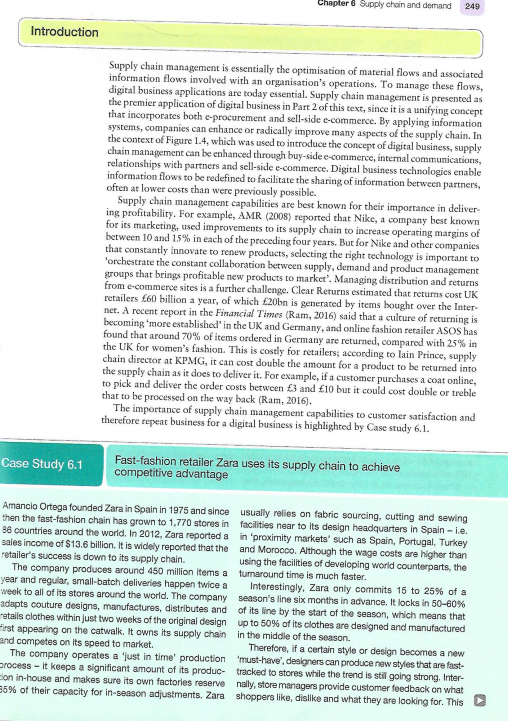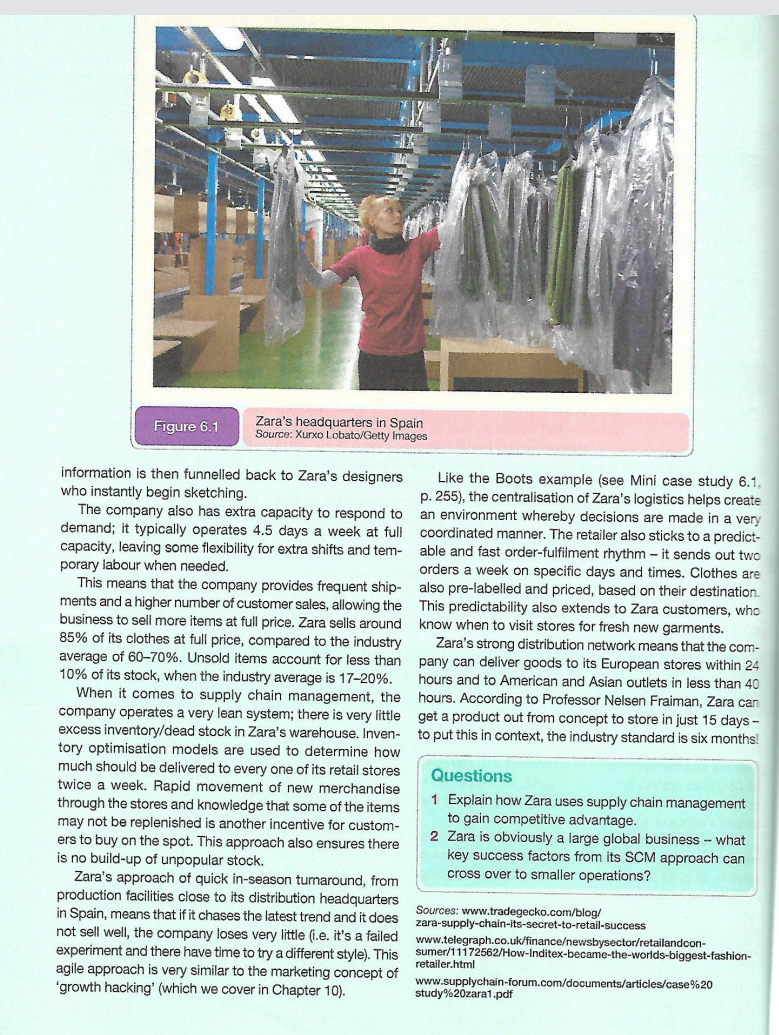Purchasing and Supply Chain Management
6th Edition
ISBN:9781285869681
Author:Robert M. Monczka, Robert B. Handfield, Larry C. Giunipero, James L. Patterson
Publisher:Robert M. Monczka, Robert B. Handfield, Larry C. Giunipero, James L. Patterson
Chapter2: The Purchasing Process
Section: Chapter Questions
Problem 1GPE
Related questions
Question
1) Explain how Zara uses e-Supply chain management to obtain a competitive advantage

Transcribed Image Text:Chapter 6 Supply chain and demand
249
Introduction
Supply chain management is essentially the optimisation of material flows and associated
information flows involved with an organisation's operations. To manage these flows,
digital business applications are today essential. Supply chain management is presented as
the premier application of digital business in Part 2 of this text, since it is a unifying concept
that incorporates both e-procurement and sell-side e-commerce. By applying information
systems, companies can enhance or radically improve many aspects of the supply chain. In
the context of Figure 1.4, which was used to introduce the concept of digital business, supply
chain management can be enhanced through buy-side e-commerce, internal communications,
relationships with partners and sell-side e-commerce. Digital business technologies enable
information flows to be redefined to facilitate the sharing of information between partners,
often at lower costs than were previously possible.
Supply chain management capabilities are best known for their importance in deliver-
ing profitability. For example, AMR (2008) reported that Nike, a company best known
for its marketing, used improvements to its supply chain to
between 10 and 15% in each of the preceding four years. But for Nike and other companies
that constantly innovate to renew products, selecting the right technology is important to
"orchestrate the constant collaboration between supply, demand and product management
groups that brings profitable new products to market'. Managing distribution and returns
from e-commerce sites is a further challenge. Clear Returns estimated that returns cost UK
retailers £60 billion a year, of which £20bn is generated by items bought over the Inter-
net. A recent report in the Financial Times (Ram, 2016) said that a culture of returning is
becoming 'more established' in the UK and Germany, and online fashion retailer ASOS has
found that around 70% of items ordered in Germany are returned, compared with 25% in
the UK for women's fashion. This is costly for retailers; according to lain Prince, supply
chain director at KPMG, it can cost double the amount for a product to be returned into
the supply chain as it does to deliver it. For example, if a customer purchases a coat online,
to pick and deliver the order costs between £3 and £10 but it could cost double or treble
that to be processed on the way back (Ram, 2016).
The importance of supply chain management capabilities to customer satisfaction and
therefore repeat business for a digital business is highlighted by Case study 6.1.
ease operating margins of
Case Study 6.1
Fast-fashion retailer Zara uses its supply chain to achieve
competitive advantage
Amancio Ortega founded Zara in Spain in 1975 and since usually relies on fabric sourcing, cutting and sewing
then the fast-fashion chain has grown to 1,770 stores in facilities near to its design headquarters in Spain - i.e.
86 countries arcund the world. In 2012, Zara reported a in 'proximity markets' such as Spain, Portugal, Turkey
sales income of $13.6 billion. It is widely reported that the and Morocco. Although the wage costs are higher than
retailer's success is down to its supply chain.
The company produces around 450 million items a turnaround time is much faster.
year and regular, small-batch deliveries happen twice a
week to all of its stores around the world. The company season's line six months in advance. It locks in 50-60%
adapts couture designs, manufactures, distributes and of its line by the start of the season, which means that
retails clothes within just two weeks of the original design up to 50% of its clothes are designed and manufactured
First appearing on the catwalk. It owns its supply chain in the middle of the season.
and competes on its speed to market.
The company operates a 'just in time' production 'must-have', designers can produce new styles that are fast-
process - it keeps a significant amount of its produc- tracked to stores while the trend is still going strong. Inter-
Elon in-house and makes sure its own factories reserve nally, store managers provide customer feedback on what
35% of their capacity for in-season adjustments. Zara shoppers like, dislike and what they are looking for. ThisD
using the facilities of developing world counterparts, the
Interestingly, Zara only commits 15 to 25% of a
Therefore, if a certain style or design becomes a new

Transcribed Image Text:Zara's headquarters in Spain
Source: Xurxo Lobato/Getty Images
Figure 6.1
information is then funnelled back to Zara's designers
Like the Boots example (see Mini case study 6.1,
p. 255), the centralisation of Zara's logistics helps create
who instantly begin sketching.
The company also has extra capacity to respond to
demand; it typically operates 4.5 days a week at full coordinated manner. The retailer also sticks to a predict-
capacity, leaving some flexibility for extra shifts and tem-
porary labour when needed.
This means that the company provides frequent ship- also pre-labelled and priced, based on their destination.
ments and a higher number of customer sales, allowing the
business to sell more items at full price. Zara sells around
85% of its clothes at full price, compared to the industry
average of 60-70%. Unsold items account for less than
10% of its stock, when the industry average is 17-20%.
When it comes to supply chain management, the
company operates a very lean system; there is very little get a product out from concept to store in just 15 days -
excess inventory/dead stock in Zara's warehouse. Inven- to put this in context, the industry standard is six months!
tory optimisation models are used to determine how
much should be delivered to every one of its retail stores
twice a week. Rapid movement of new merchandise
an environment whereby decisions are made in a very
able and fast order-fulfilment rhythm - it sends out two
orders a week on specific days and times. Clothes are
This predictability also extends to Zara customers, who
know when to visit stores for fresh new garments.
Zara's strong distribution network means that the com-
pany can deliver goods to its European stores within 24
hours and to American and Asian outlets in less than 40
hours. According to Professor Nelsen Fraiman, Zara can
Questions
1 Explain how Zara uses supply chain management
to gain competitive advantage.
2 Zara is obviously a large global business - what
key success factors from its SCM approach can
cross over to smaller operations?
through the stores and knowledge that some of the items
may not be replenished is another incentive for custom-
ers to buy on the spot. This approach also ensures there
is no build-up of unpopular stock.
Zara's approach of quick in-season tunaround, from
production facilities close to its distribution headquarters
in Spain, means that if it chases the latest trend and it does
not sell well, the company loses very little (i.e. it's a failed
experiment and there have time to try a different style). This
agile approach is very similar to the marketing concept of
'growth hacking' (which we cover in Chapter 10).
Sources: www.tradegecko.com/blog/
zara-supply-chain-its-secret-to-retail-success
www.telegraph.co.uk/finance/newsbysector/retailandcon-
sumer/11172562/How-Inditex-became-the-worlds-biggest-fashion-
retailer.html
www.supplychain-forum.com/documents/articles/case%20
study%20zara1.pdf
Expert Solution
This question has been solved!
Explore an expertly crafted, step-by-step solution for a thorough understanding of key concepts.
Step by step
Solved in 2 steps

Recommended textbooks for you

Purchasing and Supply Chain Management
Operations Management
ISBN:
9781285869681
Author:
Robert M. Monczka, Robert B. Handfield, Larry C. Giunipero, James L. Patterson
Publisher:
Cengage Learning

Purchasing and Supply Chain Management
Operations Management
ISBN:
9781285869681
Author:
Robert M. Monczka, Robert B. Handfield, Larry C. Giunipero, James L. Patterson
Publisher:
Cengage Learning